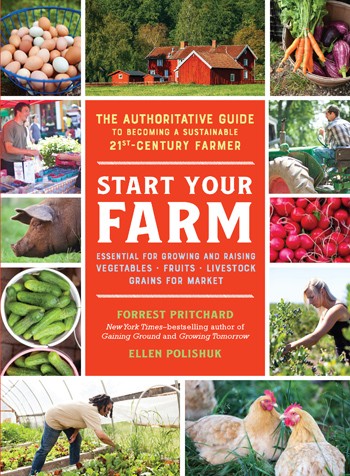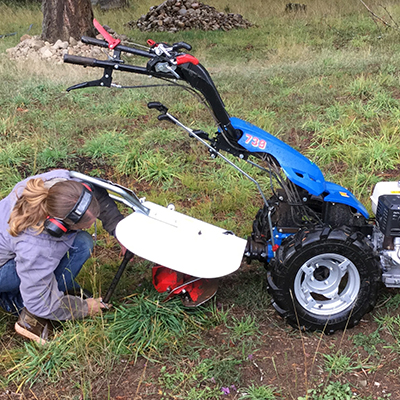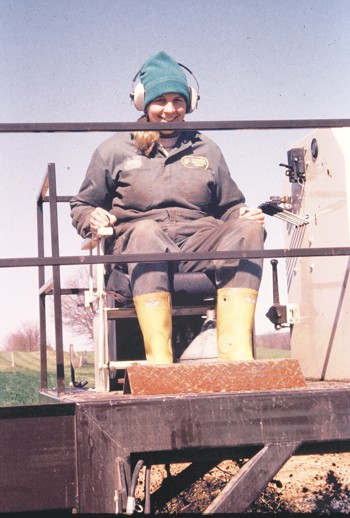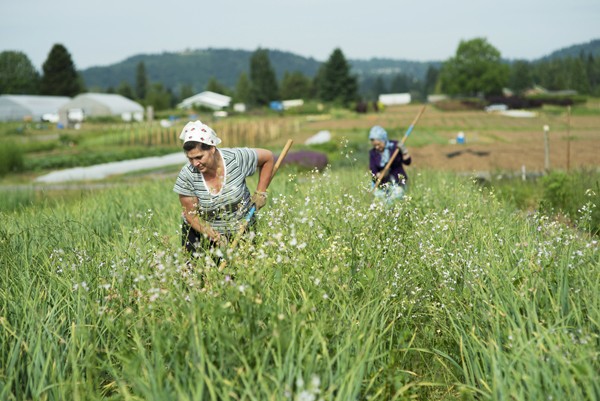By Ellen Polishuk and Forrest Pritchard
Cation exchange capacity
The best measure of a soil’s ability to hold nutrients is the cation exchange capacity (CEC). A CEC determination is part of any basic report from a soiltesting lab. In the soil, many plant nutrients take the form of cations—positively charged ions (e.g., calcium, magnesium, and potassium). Silt, clay, and humus particles, conversely, are mostly negatively charged, which attract and hold those useful cations. Anions—negatively charged ions—are either not held at all (as in the case of some forms of nitrogen, boron, and sulfur) or held through complex chemical mechanisms (as in the case of phosphorus). These anions, which are quite mobile, are nutrients that should be added on an annual basis.
Simply put, CEC measures how many cations a soil can hold. Soil scientists call the place where nutrients are held and traded the exchange complex. Imagine the soil’s CEC as the size of the fuel tank in your car. If the tank holds three gallons, you’ll need to stop at the gas station frequently; if it holds twenty
gallons, you can go a lot farther. Similarly, if a soil’s CEC is three, in order for the crop plant to have continual access to nutrients, you will have to either add amendments frequently or use slow-release fertilizers. The CEC range of most agricultural land in the United States is between three and forty.
Knowing the CEC of your soil is vital to determining how and when to add amendments. Generally speaking, the soil’s CEC is primarily determined by its sand, silt, and clay content, and as already mentioned, in most agricultural settings, you can’t really change that—it’s prohibitively expensive to add balancing tons of sand, silt, or clay. For example, to increase the sand content of a soil by 10 percent, you would need to add two hundred thousand pounds, or one hundred tons, of sand per acre, at a cost of about $2,500, not including spreading. In a small, confined space, like a hoop house or a permanent raised bed, you might be able to afford adding enough material to change the physical makeup of the soil. But out in the field, you have to banish the dream of significantly raising the soil’s CEC—it’s just not likely to move much in your lifetime. Instead, you have to learn how to live with and manage the soil you’re on.
What size is your fuel tank?
Folks in the Midwest enjoy gorgeous prairie soils with CECs in the teens and twenties. Metaphorically speaking, these soils have large fuel tanks, meaning that they can take fertility additions in larger doses and less frequently. Nutrients that are applied before seeds are planted will still be there months later as the crops reach maturity.
Growers on shallower, poorer soils, however, have CECs below ten. Truly sandy soils have CECs of three to five. Those fuel tanks are relatively small. This means that applying large amounts of quickly available fertilizer (i.e., most traditional chemical fertilizers) in advance of planting is wasteful—the soil simply does not have the chemical capacity to hang onto all those nutrients. They will move down through the soil, and out of the plants’ reach.
Instead, you either have to use small doses of highly available fertilizers multiple times throughout the season, or use fertilizers that will slowly and gradually release their nutrients, such as compost, rock phosphate, and other naturally occurring mined materials. At the same time, you need to improve the organic matter component of these soils. The more SOM you build, the more plant food the soil can hold. Remember, too, that decaying organic matter will release nutrients into the soil, so that’s a dual return for your investment—increasing nutrient capacity and content!
Soil pH
Soil pH is defined as the power of hydrogen and is the negative logarithm of the concentration of hydrogen in the soil. Now, there’s a mouthful. Basically, it’s the measure of how many of the cation exchange sites (on the CEC) are filled with hydrogen. The more hydrogen, the more acidic the soil. The important thing to know about the logarithm part of the pH scale is that the difference between a pH of 6.0 and 7.0 is not one point, it is ten points—the 6.0 soil is ten times more acidic than the 7.0 soil.
On the exchange complex, hydrogen does not feed your crops—they get adequate hydrogen from the air and water. Instead, those hydrogen atoms in the soil are occupying spots where you’d rather have nutrients such as calcium or magnesium, so the effective CEC is reduced.
Soil pH affects the exchangeability of all plant nutrients. An essentially neutral pH of between 6.8 and 7.2 (true neutral is 7.0) is the sweet spot, where the most nutrients are the most available. When the soil is very acidic (below 6.5) or very alkaline (above 7.5), many plant nutrients become “tied up” in the soil—still present but chemically unavailable to plant roots. Conversely, in pHs outside of the sweet-spot range, certain metals are overly available and can be toxic to plants and animals alike. For all of these reasons, you must balance the soil to a neutral pH (except for the few crops that thrive in acidic soils, such as blueberries and potatoes).
The application of lime (calcium carbonate, or CaCO3) is the remedy for acidic soils—those below the neutral pH of 7.0. Lime is simply limestone or chalk that’s been pulverized to the point of a fine, spreadable powder so it can perform its neutralizing magic.
Chemically, here’s how liming actually works: In an acidic soil, the carbonate (CO3) separates from the calcium, reacts with the hydrogen, and forms water (H2O) and carbon dioxide (CO2). The calcium ion trades places with the hydrogen and gets onto the exchange complex. It’s the carbonate that’s really making things happen by removing excess hydrogen. If we use dolomitic lime (CaCO3 and MgCO3), then both calcium and magnesium will take those open spaces on the complex.
Lime is typically applied in many hundreds of pounds, up to two tons per acre. Your local county extension agents can lend a hand when calculating lime rates. Extension agents are public servants whose job it is to “extend” the research and information generated at our state land grant agricultural universities to farmers and producers.
Conversely, the remedy for alkaline (or basic) soils is elemental sulfur. Soil bacteria will convert it to sulfuric acid over time, which will acidify the soil. Never use more than five hundred pounds per acre of elemental sulfur per year.
It’s important to get soil pH right. And, it’s not without cost. As you consider different sites for your farm, include the cost of adjusting the pH to your budget.
Nutrients and fertilizers
Left on its own, the earth seems to grow plants just fine. That’s comforting, but what may not be immediately obvious is that, in an undisturbed natural system, there is a closed loop of nutrients. Left alone, all of the biological products of plants and animals more or less stay inside the ecosystem. This is how our soils were built to begin with—eons upon eons of returning nutrients back to where they came from.
Then, along came modern agriculture, and the whole cycle got whacky. Today, we grow food (plants and animals) and export all of that abundance away from the farm. The problem is, unlike nature’s relatively closed-loop ecosystem, we almost never bring those nutrients back in the form of waste products. The two products that result from feeding people are human waste and human bodies. Neither of these ever make their way back to the farm that grew the food. Human effluent gets flushed “away” into waterways or captured, treated, and applied to range, forest, or, sometimes, hay land. This broken cycle means farms become net exporters of nutrients. This is a fundamental conundrum for society, to be remedied another day. In the meantime, knowing that nutrients are flowing out of your farm is essential to learning how to manage the nutrients available for crop production.
Commercial growers can’t just sit back and let nature take its course completely—recall, by definition, that isn’t farming. You don’t just hope that any old plants will grow—you plant carefully selected, specialized varieties of species, ones that your customers or your livestock want to eat. In many instances, these species would not naturally occur in your chosen ecosystem. The fundamental point is that you need to make sure that your crops, as finicky or exotic as they might be, get what they need to succeed. An understanding of fertilizer is vital.
Is fertilizer bad?
Confusion and misinformation abound regarding the relative healthfulness or harmfulness of almost all aspects of agriculture. On social media and in the press, topics of agricultural debate range from GMOs (genetically modified organisms) and noenicotinoids (neurotoxic insecticides) to hydroponics and animal welfare. Often lumped into the hopper of what is wrong with conventional Big Ag is the idea of fertilizer of any kind. And that is to our collective detriment.
Now that you understand the issue of nutrient flow, you can see that you must balance your soil by importing some nutrients. That is what fertilizer is—nutrients imported to support plant production. So, no, fertilizer is not necessarily bad. The determination of whether a fertilizer is good or bad depends on what it is exactly, how it is used, and in what amount. These are details that most casual consumers don’t care to ponder, and so the public dialogue gets stuck there. There is no doubt that fertilizers are to blame for polluting our waterways, but that doesn’t mean that all fertilizers are bad. Good old natural manure can be a huge pollution source—in the form of urea—just as surely as chemical nitrogen can.
What About Overconcentrations of Nutrients?
While underconcentrations of nutrients often occur on farms, overconcentrations of nutrients occur in the conventional livestock system in the United States, with its own problematic results. Before agriculture became highly mechanized and specialized, most farms grew some animals for their own use, as well as for sale. Now, most chickens, pigs, and beef are grown in concentrated animal feeding operations (CAFOs). These systems import vast quantities of feed (i.e., nutrients). The end result is tremendous quantities of manure, concentrated in very small areas. The soils of certain rural sections of the country, especially near processing facilities (like for chickens near the Chesapeake Bay watershed or hogs in Iowa), have become oversaturated with animal manures, resulting in pollution into streams and rivers, and aerobic dead zones (where algae blooms block sunlight) in bays.
What matters is which products are used, and the timing and amount of their application.
The federally defined word organic serves to label what is allowed or not allowed in organic food production. The USDA’s National Organic Program (NOP) determines which products and substances are allowed. The base rule is that fertilizers must be natural and not synthetic . . . except there are a few synthetics allowed. See how deep we can get into the weeds on this? If you want to pursue organic certification, you may want to begin your education on the NOP website.
For those who don’t choose organic certification, and still want to be the best biological stewards of the land, the question becomes one not purely about synthetic versus natural but also about the effect of any fertilizer on soil biology. This is an even more difficult pursuit because there is no official list of which substances are good or bad.
Thus, each of us must find our own way down this path. I chose to follow the wisdom of soils expert Gary Zimmer of Midwestern BioAg. From his perspective, some chemical fertilizers that would be prohibited for federally approved organic production are actually just fine from a soil biology angle and could be very helpful soil additions (ammonium sulfate or monoammonium phosphate, for example).
There are certainly some very common chemical synthetic fertilizers that are harsh on soil biology, such as anhydrous ammonia and triple superphosphate. As sustainable or biological farmers, we would surely avoid these. But in large doses, almost any fertilizer (including manure) could be toxic to soil life or the environment. So you take on an important responsibility as you become purchasers and managers of fertilizer.
Ellen’s journey to soil fertility
Here’s a true confession about my relationship with fertilizer. I spent the early part of my farming career believing that all the conversations about fertilizer among my colleagues was just a lot of pretending to understand what was really going on in the field. All those calculations about how much of any one nutrient was being removed by a crop—and thus what needed to be restored with fertilizer— just seemed like superfluous math to me. And as an avid consumer of organic and natural foods, I was averse to any products called “fertilizer” at all.
I chose instead to put all my effort into creating a biologically active soil, making and using excellent compost, religiously growing cover crops over the winter, and establishing soil-building crops between vegetable crops. I figured that was plenty good enough. I firmly believed that if I created a healthy soil and worked on building soil organic matter, the plants would take care of themselves. And that strategy worked really well for many years.
Then, I observed that our increase in yields hit a wall. It finally became clear to me that all that soil biology I was fostering could not create potassium, phosphorus, magnesium, calcium, or trace minerals out of thin air. Sure, biological activity wears down the rock in the soil, but very, very slowly. It struck me that if there were nutrients missing from my soil and from my compost, then they were never going to be magically manifested by soil biology. (Except in the case of the nitrogen-fixing soil bacteria associated with the plant family Fabaceae, or legumes, where symbiotic bacteria latch themselves to the plant’s roots, and literally take nitrogen from the air and fix it into a plant-available form.) I now saw that if there was not enough phosphorus in my soil, just growing more and more plants was not going to generate new phosphorus. So, my new goal became abundance, not strict self-sufficiency. My farm had been working well, but I wanted it to be even better, even more productive. I had to import specific nutrients in the form of fertilizer.
Excerpted from Start Your Farm: The Authoritative Guide to Becoming a Sustainable 21st-Century Farmer © Forrest Pritchard and Ellen Polishuk, 2018. Reprinted by the permission of the publisher, The Experiment. Available from Growing for Market.



 Farmer to Farmer Profile
Farmer to Farmer Profile
 What does it take to launch a new farm business? Perhaps more importantly, what can communities do to ensure opportunities exist for the next generation of farmers? These are questions many of us in the farm world have been grappling with as the implications of too few farmers would have profoundly negative impacts to our food system, economy, natural resources, cities, and countryside. While there are significant efforts underway across the country to support the development of new growers, this article depicts the multi-organization farmer development efforts in Northwest Oregon.
What does it take to launch a new farm business? Perhaps more importantly, what can communities do to ensure opportunities exist for the next generation of farmers? These are questions many of us in the farm world have been grappling with as the implications of too few farmers would have profoundly negative impacts to our food system, economy, natural resources, cities, and countryside. While there are significant efforts underway across the country to support the development of new growers, this article depicts the multi-organization farmer development efforts in Northwest Oregon.